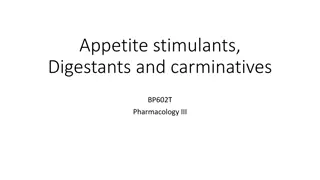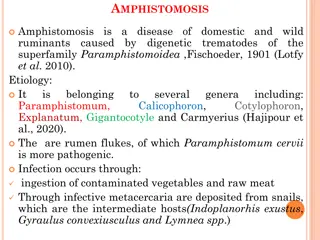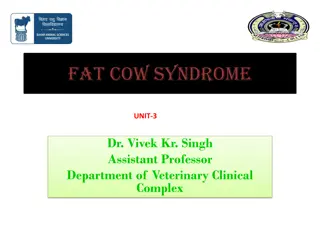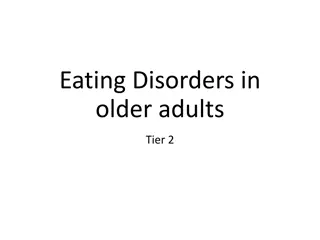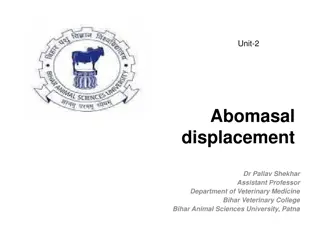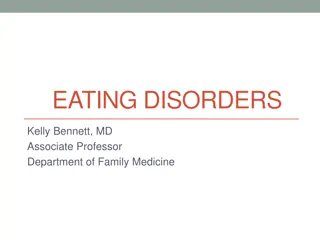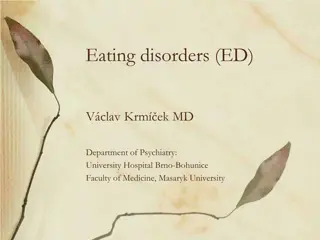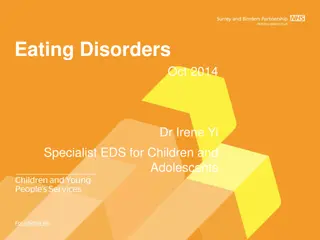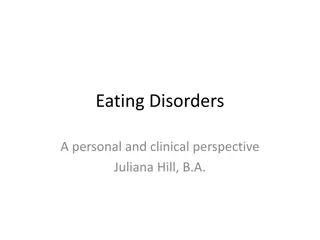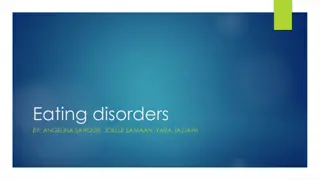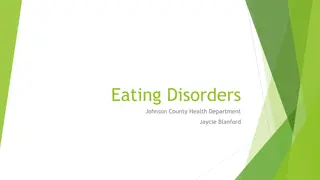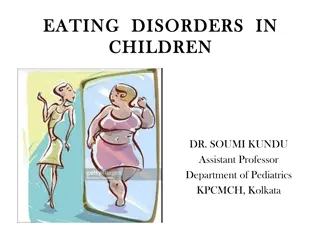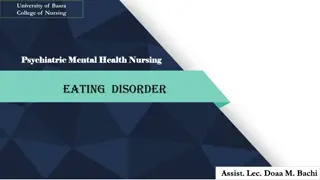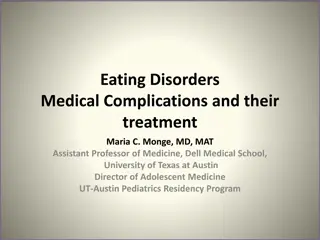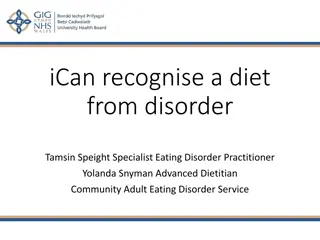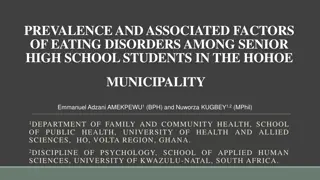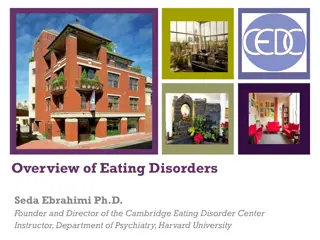Understanding Anorexia Nervosa: Causes, Symptoms, and Treatment
Eating disorders, particularly anorexia nervosa, are serious psychological illnesses characterized by abnormal eating habits leading to detrimental effects on physical and mental health. This lecture discusses the definition, etiology, clinical features, and treatment options for anorexia nervosa, highlighting the importance of awareness and intervention. Genetic and social causes, along with individual psychological factors, contribute to the development of this disorder, emphasizing the need for comprehensive care and support for those affected.
Download Presentation

Please find below an Image/Link to download the presentation.
The content on the website is provided AS IS for your information and personal use only. It may not be sold, licensed, or shared on other websites without obtaining consent from the author. Download presentation by click this link. If you encounter any issues during the download, it is possible that the publisher has removed the file from their server.
E N D
Presentation Transcript
EATING DISORDERS ANOREXIA NERVOSA LECTURE NO : 2 DEPARTMENT OF MENTAL HEALTH NURSING VSPM S COLLEGE OF NURSING & RESEARCH CENTRE, NAGPUR
PURPOSE STATEMENT At the end of the session the students will be able to gain knowledge regarding anorexia nervosa and will apply this in to clinical practice.
LEARNING OBJECTIVES Sr no Learning objectives Define eating disorder. Domain Cognitive Level Must Know Must Know Must Know 1 2 Define anorexia nervosa. Cognitive 3 Enlist nervosa. etiology of anorexia Cognitive 4 Enlist the clinical features of anorexia nervosa. Cognitive Must Know 5 State anorexia nervosa. the complications of Cognitive Must Know
LEARNING OBJECTIVES Sr no Learning objectives Domain Level 6 Explain course and prognosis Cognitive Must know Must know 7 Explain the diagnosis for anorexia nervosa. Cognitive 8 Explain the treatment for anorexia nervosa. Cognitive Must know 9 Enlist the nursing interventions for anorexia nervosa Cognitive Must know
DEFINITION EATING DISORDER Eating disorders are psychological illnesses defined by abnormal eating habits that may involve either insufficient or excessive food intake to detriment of an individual s physical and mental health. The two most important eating disorders are Anorexia nervosa Bulimia nervosa
DEFINITION Anorexia Nervosa Anorexia is a prolonged loss of appetite. Anorexia nervosa is characterized by highly specific behavioral and psychopathological symptoms and significant somatic signs. Majorities are females and the onset is during adolescence. The core psychopathological feature is the dread of fatness, weight phobia and drive for thinness.
ETIOLOGY Genetic causes: Among the female siblings of patients with established anorexia nervosa,6 -10% suffers from the condition compared to the 1-2% found in the general population of the same age (Strober,1995) Adisturbance in hypothalamic function.
Cont..... Social factors: There is high prevalence of anorexia nervosa among female students and particularly concerned with weight (for example, dancers). Influence of mass media, beauty contests are their important social causes. in occupational groups Individual psychological factors: A disturbance of body image, a struggle for control and a sense of identity are important factors in the causation of anorexia nervosa. Traits of low self- esteem and perfectionism are often found.
Cont.... Causes within the family: Disturbance in the family relationships, over protection, family members having an unusual interest in food and physical appearance.
CLINICAL FEATURES There is an intense fear of becoming obese. This fear does not decrease even if the person loses weight grossly and becomes very thin. The body weight is 15 percent below the standard weight. There is a body image disturbance. The patient is unable to perceive the body size accurately.
Cont.... The pursuit of thinness may take several forms. Patients generally eat little and set themselves daily calorie limits (often between 600 and 1000 calories).Some try to achieve weight loss by including vomiting, excessive exercise and misusing laxatives. Other signs and symptoms are secondary to starvation and include sensitivity to cold, delayed gastric emptying, constipation, low blood pressure, bradycardia, hypothermia and amenorrhea in females.
Cont.... Vomiting and abuse of laxatives may lead to a variety of electrolyte disturbances, the most serious being hypokalemia. Hormonal abnormalities also may be seen. Psychological findings Preoccupation with body size, distorted body image, description of herself as fat.
COMPLICATIONS Resulting from the malnutrition, dehydration and electrolyte imbalances caused by prolonged starvation, vomiting and laxative abuse. Increased susceptibility to infection. Hypoalbuminemia. Chronic inflammatory bowel disease (due to laxative abuse).
Cont.... Esophageal erosion, ulcers, tears, bleeding, gum erosion, dental caries. Amenorrhea. Life increasing cardiovascular complications.
COURSE & PROGNOSIS Anorexia nervosa often runs a fluctuating course with periods of exacerbations and partial remissions. Outcome is very variable.
DIAGNOSIS Complete physical examination including laboratory tests Complete blood testing. Differential diagnosis Based on ICD10 criteria.
TREATMENT Pharmacotherapy Neuroleptics Appetite stimulants Antidepressants Psychological Therapies Individual psychotherapy Behavioral therapy Cognitive behavior therapy Family therapy
NURSING DIAGNOSIS- Imbalanced nutrition less than body requirements 1. related to refusal to eat. 2. Deficient fluid volume related to decrease fluid intake self induced vomiting and diuretic abuse. 3. Anxiety related to feeling of helplessness and lack of control over life events. 4. Disturbed body image related to ego development dysfunctional family
NURSING INTERVENTION Maintain a strict intake and output chart. Monitor status of skin and oral mucous membranes. Encourage the patient to verbalize feelings of fear and anxiety related to achievements, family relationships and intense need for independence. Encourage family to participate in education regarding connection between family process and the patient s disorder.
Avoid discussions that focus on food and weight. Short term management is focused on ensuring weight gain and correcting nutritional deficiencies. Maintaining normal weight and preventing relapses are long term goals to be achieved. Hospitalization is usually required and successful treatment depends on good nursing care, with clear aims and understanding on the part of the patient as well as the nurse.
Eating must be supervised by the nurse and a balanced diet of at least 3000 calories should be provided in 24 hours. In the early stages of treatment, it is best for the patients to remain in bed in a single room while nurse maintains close observation. The goal should be to achieve a weight gain of 0.5 to 1kg per week.
Weight should be checked regularly. Monitor serum electrolyte levels and signs and symptoms like amenorrhea, constipation, hypoglycemia, hypotension etc. Control vomiting by making the bathroom inaccessible for at least 2 hours after food. In extreme cases when the patient refuses to eat and comply with the treatment, gavage feedings may need to be instituted.
SUMMARY So far, we have discuss about Eating disorder. Anorexia nervosa. Etiology of anorexia nervosa. Clinical features of anorexia nervosa. Complications of anorexia nervosa.
Cont.... Course and prognosis. Diagnosis for anorexia nervosa. Treatment for anorexia nervosa. Nursing interventions for anorexia nervosa.
APPLIED ASPECTS By this class the student nurse will be able to plan care for patient with anorexia nervosa.
REFERENCES R Sreevani , A guide to mental health and & psychiatric nursing 3 rd edition , jaypee publishers . Niraj Ahuja , A short text book of psychiatry 20 th year edition , jaypee publishers .
MUHS EXAM APPEARED QUESTIONS Explain about Anorexia nervosa (SAQ 5 marks)
ACKNOWLEDGEMENT Department wishes to acknowledge with thanks Efforts of Ms Liji Varghese for making this LRM Staff of the department for content validation MET department for guidance & format validation


